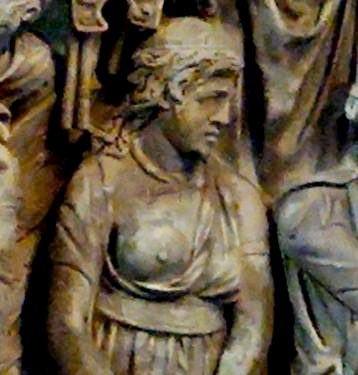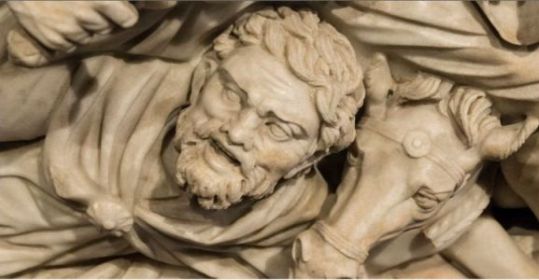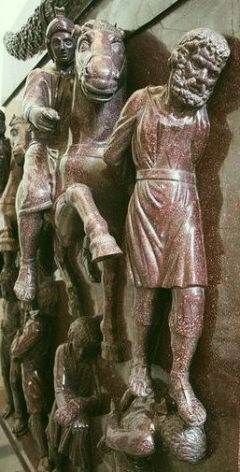
Romans and Goths on the Danube and Black Sea
It is said that around the year 245 AD the Ostro-Goths lived near the Danube estuary into the Black Sea led by their first king of the Amal lineage, Ostrogotha, who was famous for his patience. In any case, he was famous, his reputation reached all the way to England as he is mentioned in the famous Widsith poem from about 800 AD: “East-Gotan frodne and godue, fæder Unweness”. Jordanes calls, however, his son Hunuil.
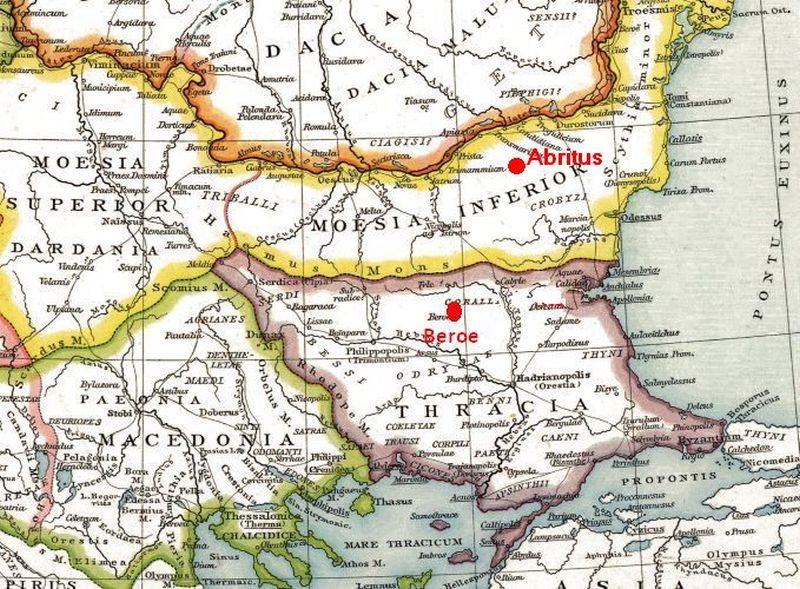 |
Dacia was a Roman province in the early Roman Empire, which stretched north of the Danube. Most of its area belongs to Romania today. Dacia was conquered by Emperor Trajan 101-106 AD but already in 270 AD Emperor Aurelian chose to evacuate Dacia and pull the border of the Roman Empire back to the Danube, which was far easier – and less expensive, to defend. Some sources say that the Romans effectively lost Dacia already around 250 AD – Dacia was fairly quickly taken over by the Western Goths, among which the Visi-Goths were the dominant tribe. Then, Moesia, Thracia and Macedonia became targets for Gothic plunder. Beroe and Abrittus are marked in red.
It is also said that the Goths through twenty years received an annual sum of money to protect the Roman border against the Sarmatians. But Emperor Philippus Arabs, who ruled 244-249 AC stopped payments, prompting the patient king Ostrogotha to lose patience and lead his Goths into the nearby Roman provinces, Dacia, Moesia and Thracia in order to loot.
In 249 AD the Roman general Decius made rebellion against Emperor Philippus and had himself declared emperor by his troops. Philippus was killed in a battle near Verona. Goths under King Cniva took advantage of the prevailing chaos and were preparing to lay siege to Nicopolis on the Danube, when they were surprised by the freshly made emperor and had to escape through the difficult terrain of Balkans, however, here they received reinforcements and turned surprisingly against their pursuers and attacked and plundered their camp near Beroe, which today is called Stara Zagora, and then it was the Romans, who had to flee. It was the first time a Roman emperor fled in a confrontation with the Gothic barbarians.
Then the Goths conquered Philippopolis, which today is called Plovdiv and returned to their homeland laden with booty and important prisoners.
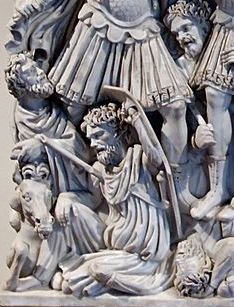 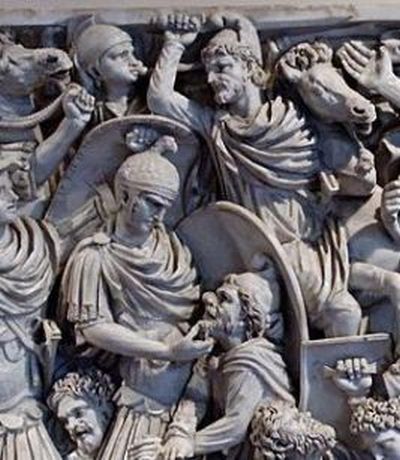 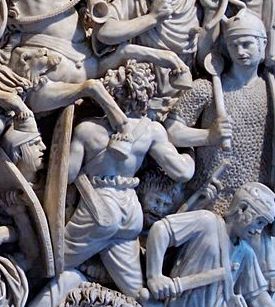  |
Details from the Ludovisi sarcophagus, a Roman sarcophagus found in a grave near Porta Tiburtina in Rome. It is dated to around 250 AD. It was discovered in 1621 and named after its first modern owner, Ludovico Ludovisi. The sarcophagus is now displayed in Palazzo Altemps in Rome, which is a part of the National Museum in Rome. The motive is a Roman victory over barbarians, in all likelihood Goths. Note their curly hair; both Sidonius Apollinaris and Jordanes mention that the Goths had curly hair. All the Goths have beards. Photo Wikipedia.
From upper left to lower right:
A Goth is mortally wounded by a spear in the chest.
A Roman lifts the head of a dying Goth by the beard. Above a Got lifts his sword, he is wearing a kind of hat.
A Goth is struggling desperately against superior forces surrounded by fallen comrades.
A heap of fallen Goths in the bottom of the motive, all dressed in tight pants and with curly hair and beard.
Emperor Decius and his son Herennius Etruscus soon sought to wash away the humiliation at Beroe by moving their troops across the Danube and attack the Goths. The decisive battle took place in 251 AD on the swampy terrain of the small town, Abrittus, which today is called Razgrad, in northeastern Bulgaria. The Roman writer Sextus Aurelius Victor recounts: “After he had ruled for two years Decius and his son Abrittus died because of treason while pursuing the barbarians over the Danube. Many reports tell that his son fell in battle, while he pushed in a too daring attack; the father, however, strenuously argued that the loss of a single soldier seemed him too little to matter. And then he resumed the fight and died violently struggling in a similar way.” His body was never found. Decius was the first Roman emperor, who died in battle against the kingdom’s external enemies.
The Byzantine theologian and historian Zonaras narrated: ” – he and his son and a large number of Romans fell into the marshland; all of them perished there, none of their bodies to be found, as they were covered by the mud.”
|
|
Details from the Portonaccio sarcophagus, which is a Roman sarcophagus found in the Portonaccio neighborhood of Rome It is dated 180-190 AD and can be seen in Museo Nazionale Romano.
Top: A barbarian woman with one breast exposed. In several columns and reliefs, Germanic women are shown with one breast exposed and the hair in disorder. It may be thought to have been a particularly advanced Germanic fashion from the Migration Period, but it is more likely that it should demonstrate the harsh treatment that the legionaries gave the subdued’s women, as a symbol of the Roman armies’ omnipotence.
Bottom: A barbarian warrior and his horse are in trouble in the bottom of the battle. All Germans, Goths and Dacians are shown with curly hair and beard. – Wikipedia.
The Romans raised an outcry when it became known that Gallus – the new emperor after the disaster at Abrittus – paid the Goths to keep the peace. However – unfaithful to their leaders’ agreements – some groups of Goths continued to loot in the Roman province Elyria (Albania). However, they were quickly beaten by a general named Aemilianus, who then was proclaimed emperor. Gallus was murdered by his own soldiers, who then joined the usurper’s army; but soon after he too was murdered, and the empire came into the hands of Valerian and his son Gallienus. But in 260 AD Valerian led a daring expedition in the war against the Persians and never came back.
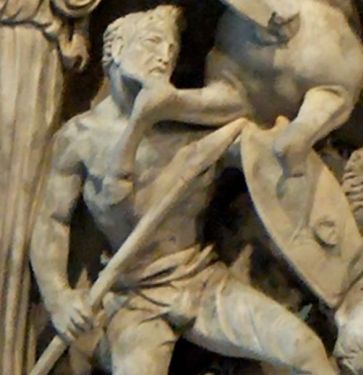
Battle scene between Romans and Germans on the Portonaccio sarcophagus. One of the Germans, Dacian or possibly Gothic warriors is still standing. He could be a typical Gothic warrior armed with spear and shield – with curly beard and hair, dressed in tight pants held up by a belt, like the typical Germanic trousers found in Thorsbjerg Mose near Slesvig. Photo: Wikipedia.
During these fifteen years from Ostrogotha’s raids into Moesia and Thracia until Emperor Decius’ death in the battle of Abrittus, other Goths along with other barbarians conducted massacres and looting many places in the Roman Empire. Heruls, Goths and Eudoses, which probably also were Goths, from Crimea sailed across the Black Sea and captured the great city of Trebizond, where they abducted a large number of prisoners and took a big prey. The same fate befell the large and splendid cities of Bithynia, Chalcedon and Nicomedia. It is said that they were all fortified with strong garrisons, but for fear of Gothic terror, resistance was rarely attempted.
However, the most known and infamous Gothic raid was the conquest and looting of Athens in 262 AD. A fleet of five hundred ships – it is said – led a large army of Goths and Heruls through the Bosphorus and Hellespont. On their way to Athens, they destroyed the city of Cyzicus, which stood at the coast of Asia Minor between the Bosphorus and Hellespont, and they burned down the famous Temple of Diana in Ephesos, with its hundreds of tall marble columns and many beautiful statues – one of the ancient Seven Wonders.
Then the Gothic pirates crossed the Aegean Sea, anchored off Athens and plundered the famous city – Plato and Socrates’ birthplace – completely. But at least they did not burn the city, and we know that they left many distinguished and beautiful buildings and artworks, which first would be destroyed by the Turks many years later.
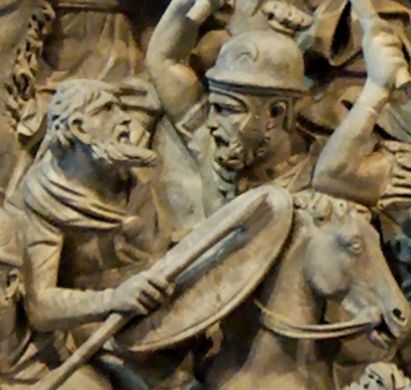
Battle scene between Romans and Goths on the Portonaccio sarcophagus. A bearded bareheaded Gothic warrior armed with shield and spear in battle against a similarly bearded Roman legionary equipped with helmet and sword. As several other Goths, he is wearing a cape held together by a buckle on the chest. Photo: Wikipedia.
When they had finished looting of Greece, they went to the coast of the Adriatic Sea. Maybe they thought of invading Italy. But however, Emperor Gallienus, Valerian’s son, had finally woken up to action and led a large army against them. The expedition leaders began to quarrel among themselves, and one of the Heruli leaders, Naulobatus, went into Roman service with all his men. He was very well received by the emperor, who gave him the rank of consul. The remaining Goths divided into two groups. One group went to Greece’s east coast and from there by ship to Thracia, and from there they traveled over land home to their villages. The other group continued to ravage Moesia another year without meeting significant resistance because of continued rivalry between the Roman generals.
In 268 AD, Emperor Gallienus was assassinated, and Claudius was appointed to emperor. In his time Greece was attacked by an invading army of thousands of Goths, who had emigrated from the area near the mouth of Dniester at the Black Sea, bringing their wives and children. The invasion army landed near Thessalonica and was soon engaged in grueling battles with Claudius forces. Thousands of Gothic prisoners were sold as slaves; many young men were enrolled in the imperial armies. A plague ravaged both Goths and Romans. The rest of the Goths fled into the Balkan mountains. For this victory, Emperor Claudius earned his name of honour, Gothicus.
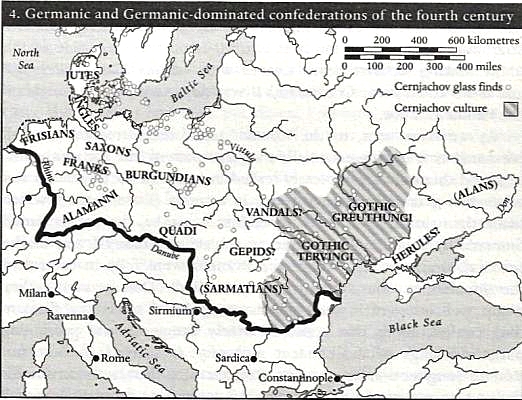
The barbarian peoples along the borders of the Roman Empire in the fourth century by Peter Heather: “The Fall of the Roman Empire – A new history”. Jordanes narrated that after the Goths had arrived in the Black Sea area, they divided themselves into two groups, which usually are called respectively Tervingi – Visigoths – Western Goths and Greutungi – Ostrogoths – Eastern Goths. But the most likely is that there were many Gothic tribes, who had emigrated from the overpopulated original Gothic area in South Scandinavia and around the Baltic. Tervingi and Greutungi were only the names of dominant tribes. It is not even sure that for example, Tervingi and Visigoths represented the same tribe. We know, for example, that also Eudoses and Rugi were part of the exodus. Moreover, as Procopius writes about the barbaric peoples, he had met: “All these, while they are distinguished from one another by their names, as has been said, do not differ in anything else at all. For they all have white bodies and fair hair and are tall and handsome to look upon, and they use the same laws and practice a common religion.” Vandals, Gepids, Scirii, Burgundians and Angles talked all a dialect of Gothic and also resembled each other, so technically one could call them all a kind of Goths.
On His deathbed, Claudius appointed a young man named Aurelian as emperor. Very soon the empire was again attacked by new hordes of Goths led by a chief named Cannabaudes. Aurelian concluded a settlement with the Goths so that the province of Dacia, which today mainly is made up by Romania and the eastern part of Pannonia, which is today’s Hungary, was finally abandoned to the Goths against that they provided two thousand cavalries to the Roman army, and sent young men and women of noble families to the Roman Empire as hostages. The result of these agreements were the Goths lived in peace with the Roman Empire in the following fifty years.
A Goth – or could it be a Persian – is taken away captive of the Roman cavalry – Motif on Constantine’s mother Helena’s sarcophagus in Pio-Clementine Vatican Museum in Rome. He has curled hair and beard and is dressed in robe and pants. However, these pants are unusual being knee short – Wikipedia.
The Goths broke the peace in 322 AD when a unified army of Eastern and Western Goths and several Slavic tribes led by King Aliquaca invaded the Roman provinces south of Danube. But however, Emperor Constantine, who later earned the name of honour, “the Great,” responded by crossing the Danube and defeat them on their own territory. The emperor offered however honorable peace terms, the Goths were allowed to keep all their possessions and privileges against that the king should send his son as a hostage to Constantinople, and that Gothic forces should participate in the Imperial Army. When Constantine a year later fought the decisive battle against his rival, Licenius at Hadrianople, he was therefore assisted by a large Gothic army under Aliquaca. The victory at Hadrianople gave Konstantin power throughout the Roman Empire and made it possible that he could declare Christianity as the religion of the state.
Around 350 AD the Goths on the banks of the River Dnieper chose Ermanaric of the Amal lineage as king. Not since Ostrogotha, they had had an Amal as king. Ermanaric made no attempt to invade the provinces of the Roman Empire, but he made his Gothic kingdom to the center of a great empire. The Roman Ammianus Marcellinus wrote that he ruled “extensive large and fertile areas”; Jordanes wrote that he ruled the country Oium and compared him with Alexander the Great. Through many generations, his fame survived in Scandinavian, German and Anglo-Saxon sagas and poems. In “The saga of Hervarar and Kong Heidrek” the Goths’ capital is called Arheimar and located at the Danpar river, which is the Dnieper. The name Árheimar has been interpreted as Oium, as place names with the suffix -heim in many cases have been reduced to -um.
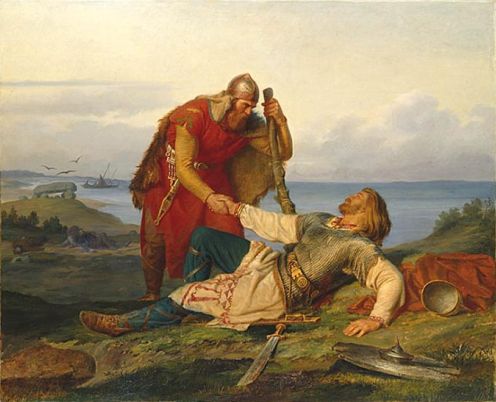
Scene from Heidreks Saga – Hjalmar’s farewell to Orvar Odd after the fight on Samsø. Painted by Mårten Eskil Winge – Wikipedia.
In this saga, Heidrek unfairly usurps the throne of Reidgotaland. He kidnaps the Hunnish princess Sifka, rapes her and sends her pregnant back to the Huns, her son with Heidrek is given the name Hlød. When Heidrek dies in the Carpathians, he is succeeded by his son Angantyr. But his second son Hlød, who had grown up among the Huns, requires his heritage and attacks with a great Hunnish army of mounted warriors. The Goths are assisted by the old Geatian King Gissur, and the war ends in an epic battle on the plains of the Danube, where Angantyr kills his brother Hlød.
We can understand from sagas and poems that Ermanaric was admired as a great conqueror and ruler, but he was also bitterly hated by the subjugated peoples as a cruel tyrant.
In the western part of the Gothic area along the Black Sea, King Athanaric of the Western Goths reigned. Since the time of Constantine the Great, they had faithfully complied with the agreement to protect the empire’s eastern border and to send several thousand soldiers to the Roman army each year. However, Athanaric made the mistake to support the wrong emperor. A general named Procopius rebelled against Emperor Valens, and temporary he got the power in Constantinople. Athanaric sent his Gothic troops to Thrace to support Procopius in the belief that he was the real emperor. However, Valens came back strongly, overcame his rival and his Gothic troops, whom he reportedly sold as slaves. Moreover, Valens then went over the Danube with his legions and made war and plunder on the Goths, however, without he was able to win a decisive victory.
After three years of war between the Western Goths and the Romans King Athanaric met with Emperor Valens in 369 AD on a barge on the Danube and agreed to peace terms; among others, Valens agreed to Athanaric’s requirement to deliver the Gothic Christians, who had sought refuge in Constantinople.
Preserving the Past, Recording the Present, Informing the Future
Ancient and Honorable Carruthers Clan Int Society
carruthersclan1@gmail.com carrothersclan@gmail.com

Dr Patricia Carrothers
Reviewed by Tammy Wise CHS
CLAN SEANACHAIDHI
CLAN CARRUTHERS INT SOCIETY CCIS HISTORIAN AND GENEALOGIST

You can find us on facebook at :
https://www.facebook.com/carrutherscarrothers.pat.9
https://www.facebook.com/CarruthersClan/
https://www.facebook.com/CarruthersClanLLC
Disclaimer Ancient and Honorable Carruthers Clan International Society
Goterne Wikipedia – her opregnes de 12 forskellige kendte grupper af Goter, som kendes i historiske kilder.
Jordanes GETICA sive De Origine Actibusque Gothorum Harbor.net – på latin og engelsk.
Cassiodorus, Jordanes and the History of the Goths Arne Søby Christiansen – Tusculanum Press.
Gothic Online Linguistics Research Center – The University of Texas at Austin.
History of the Goths by Herwig Wolfram Google Books
Procopius of Caesarea – History of the Wars I and II – The Persian War Project Gutenberg.
Procopius of Caesarea – History of the Wars III and IV – The Vandalic War Project Gutenberg.
Procopius of Caesarea – History of the Wars V and VI – The Gothic War Project Gutenberg.
Procopius in seven volumes Internet Archieve
Procopius of Caesarea – The Secret History of the Court of Justinian Project Gutenberg.
The story of the Goths, from the earliest times to the end of the Gothic dominion in Spain” by Henry Bradley Internet Archieve.
Sidonius Apollinaris, Letters Book I The Tertullian Project
Full text of “Poems and letters – SIDONIUS A new Internet Archive.
The Roman History of Ammianus Marcellinus of the Loeb Classical Library edition, 1939
Battle of Abritus Wikipedia
“Die Goten – von den Anfangen bis zur Mitte des sechsten Jarhrhundert” Herwig Wolfram – C.H. Beck (findes også på engelsk)



